Costa Rica, Central America’s most popular destination, is a beautiful country with lush nature, diverse wildlife, pristine beaches, and outdoor activities.
Ten days is enough time to visit several of the country’s best travel spots and experience their top attractions.
I spent two amazing weeks in Costa Rica, and here, I share amazing things to do and tips on optimizing your trip itinerary. This post covers:
- 🗓️ Two 10-day optimized itineraries
- ⭐️ Top attractions in 4 destinations
- 📍 Costa Rica map with key places
- 💎 Firsthand travel tips
- 🏠 Where to stay
- ✏️ Costa Rica trip planner
Planning a trip? Here’s what to know about Costa Rica.
Lists By Lukiih is readers-supported. When you buy with my affiliate link, I may earn a small commission. Thanks!
Costa Rica Itinerary Route
This itinerary takes you to some of Costa Rica’s best places:
- La Fortuna – the adventure capital of Costa Rica.
- Monteverde – home of the world-famous cloud forests.
- Manuel Antonio – one of the country’s best tropical beaches.
- Nosara – a tranquil surfing and yoga beach town.
About This Costa Rica Itinerary
This Costa Rica itinerary efficiently sequences attractions and activities the country is famous for. It gives you the opportunity to:
- Visit cloud forests and rainforests to spot unique wildlife
- Enjoy natural hot springs heated by an active volcano
- Snorkel and visit tropical beaches with sandy, white sand
- Go on thrilling outdoor activities like whitewater rafting
- Eat traditional Costa Rican food at local restaurants
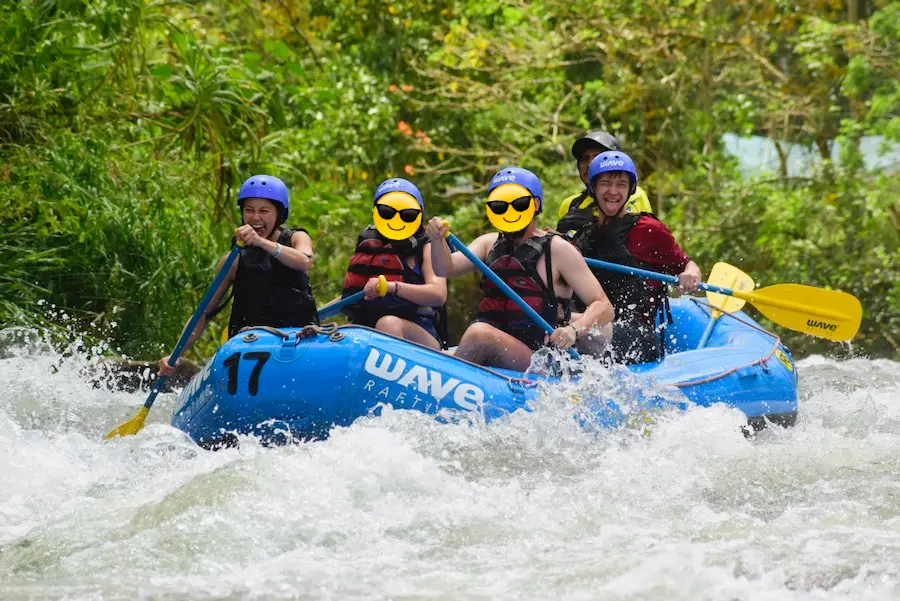
7 Essential Tips for Visiting Costa Rica
Before getting into the itinerary, here are practical tips to know when traveling to Costa Rica.
🚙 1. Decide if you want to drive.
Although many visitors choose to visit the small country on a road trip, Costa Rica is also known for its winding and poorly maintained roads.
If you plan to rent a car, be prepared for potholes, one-way bridges, passing (or getting passed), and low cell signal on some main roads. A 4×4 vehicle is highly recommended in some areas.
For all the reasons mentioned, I didn’t get a rental car. If you don’t plan to either, learn the different ways to get around Costa Rica.
📱 2. Download WhatsApp.
Almost everyone in Costa Rica, including hotel concierges, Airbnb hosts, tour operators, taxi drivers, and others, communicates through WhatsApp (iOS, Android).
Make sure to download the app in advance, as it is the best way to communicate with locals.
💰 3. Prepare to budget and tip.
Tourism is Costa Rica’s biggest industry and main source of income, so it’s not surprising that it’s one of the most expensive countries to visit in Central America.
Hotels are usually $100 USD a night, and many activities require an organized guided tour, have an entrance fee, or are best with a tour guide.
Costa Rica also has a tipping culture, so expect to add 5% to 10% to all tours and services.
I share all my travel expenses in this Costa Rica cost breakdown.
💵 4. Bring cash (and USD is accepted).
Many tourist areas accept credit cards, but you should bring cash for smaller, local businesses and tipping.
The US dollar is widely accepted in Costa Rica. However, you may not get the best exchange range if you pay in USD.
🥭 5. Eat fruits and look for wildlife.
Costa Rica is a great place to eat fresh fruits, so be sure to stop by fruit stalls or order them at restaurants (ask locals what’s in season).
Wildlife is everywhere, so even though you’ll have a higher chance of spotting them with a local guide, you can also find them on your own. Some unique animals you’ll be able to see include howler monkeys, toucans, sloths, and coatis.
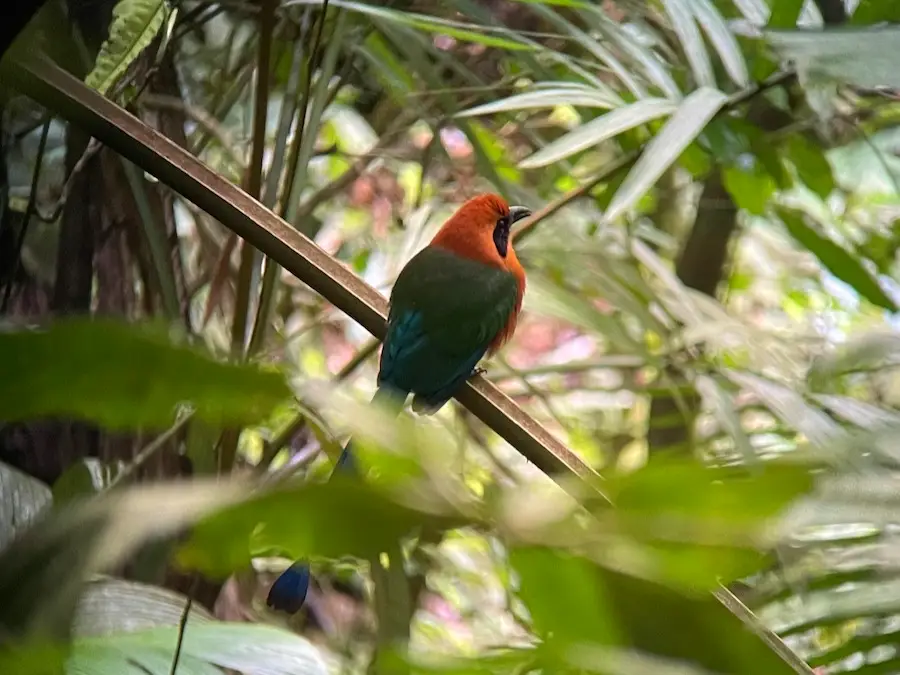
☀️ 6. Pack bug repellent and sunscreen.
The Costa Rican government has run multiple campaigns to decrease the spread of mosquito-borne illness, but some areas still have a lot of mosquitoes.
Mosquitoes are present year-round, but they are worst during the rainy season from May to November.
I tend to get bitten and find that this insect repellent lotion works better than the spray kind (per the CDC: “DEET offers the best protection against mosquito bites”).
Also, Costa Rica is near the equator, so you can sunburn easily. I made sure to bring my face sunscreen to every area I visited.
😵💫 7. Pack motion sickness medication.
Costa Rica has a lot of bumpy and winding roads. If you plan to travel by land and you get motion sickness, bring your medication.
I get car sick and I had to use my medication for almost all my shuttle rides (e.g., from Liberia to Nosara, Nosara to Monteverde, Monteverde to La Fortuna, and La Fortuna to Manuel Antonio).
Learn other practical tips when traveling to Costa Rica.
Costa Rica Map
This map has all the recommended places in the Costa Rica travel itinerary below.
10-Day Itinerary for Costa Rica
Below is a great way to spend ten days in Costa Rica. To help you plan efficiently, I’ve included suggested times for each activity based on my firsthand experience.
The Costa Rica trip planner below has a one-week itinerary prefilled that you can modify to fit your needs.
| Day 1 – La Fortuna (4 days) | ||
| ✈️ | Arrive in San Jose airport | Morning |
| 🚗 | Travel to La Fortuna | Afternoon |
| ♨️ | Settle down and enjoy a hot spring | 4–9 pm |
| Day 2 – La Fortuna (4 days) | ||
| 🍫 | Go on a coffee and chocolate tour | 10 am–12:30 pm |
| 🌋 | Horseback ride around Arenal Volcano | 1–4:30 pm |
| Day 3 – La Fortuna (4 days) | ||
| 🌳 | Visit the Mistico Arenal Hanging Bridges | 7:30–11:30 am |
| 💧 | Visit La Fortuna Waterfall | 1–2 pm |
| 🚡 | Go up the La Fortuna sky tram | 2:30–4 pm |
| 🛍️ | Explore La Fortuna town area | 5–7 pm |
| Day 4 – La Fortuna (4 days) | ||
| 🍃 | Zip line through a rainforest | 7:30–10:30 am |
| 🌊 | Raft in a whitewater river | 11 am–4 pm |
| ♨️ | Enjoy another hot spring or rope swing at El Salto | 5–7 pm |
| Day 5 – Monteverde (2 days) | ||
| 🚗 | Travel to Monteverde | Morning |
| 🦋 | Visit the Monteverde Butterfly Garden | Afternoon |
| 🦇 | Go on a wildlife refuge night walk | 7:30–10 pm |
| Day 6 – Monteverde (2 days) | ||
| ☁️ | Explore the Monteverde Cloud Forest | 7:30–11 am |
| 🦥 | Visit the sloth sanctuary | 1–2 pm |
| 🌳 | Zip line over a cloud forest | 2:30–5 pm |
| OPTION #1: Manuel Antonio Day 7 – Manuel Antonio (3 days) | ||
| 🚙 | Travel to Manuel Antonio | Morning |
| 🏖️ | Relax or snorkel at Playa Biesanz | 2–4 pm |
| ☀️ | Catch the sunset at El Avión | 6–7:30 pm |
| Day 8 – Manuel Antonio (3 days) | ||
| 🐒 | Hike and beach at Manuel Antonio National Park | 9:30 am–4 pm |
| ☀️ | Catch the sunset at Espandilla Beach | 6–7:30 pm |
| Day 9 – Manuel Antonio (3 days) | ||
| 🏄🏻♀️ | Do a day trip to Jaco or Nauyaca Waterfall | All day |
| OPTION #2: Nosara Day 7 – Nosara (3 days) | ||
| 🚗 | Travel to Nosara | Morning |
| 🧘🏻 | Do an outdoor walk-in yoga | Afternoon |
| 💆🏻♀️ | Get an outdoor massage | Afternoon |
| 🌤️ | Catch the sunset at Guiones Beach | 5:30–6:45 pm |
| 🎵 | Live music and dinner at Beach Dog Cafe | 7–8:30 pm |
| Day 8 – Nosara (3 days) | ||
| 🏄🏻 | Take surf lessons | 7:30–9 am |
| 🚲 | Bike and explore Nosara’s town | 11 am–1:30 pm |
| 🧘🏻 | Do a walk-in yoga class while enjoying the environment | 2:30–3:30 pm |
| 🌙 | Have dinner and catch the sunset at La Luna | 5:30–7:30 pm |
| Day 9 – Nosara (3 days) | ||
| 🏄🏻 | Take surf lessons | 7:30–9 am |
| 🏍️ | Go on an ATV ride tour | 10 am–3 pm |
| ⛅ | Catch the sea turtles at Ostional Beach | 4–6 pm |
| 🐠 | Have dinner at Harmony Cafe | 7–8 pm |
| Day 10 – Departure | ||
| ✈️ | If leaving from Manuel Antonio, travel to San Jose’s airport to depart | Morning |
| ✈️ | If leaving from Nosara, travel to Liberia’s airport to depart | Morning |
🗓️ Nosara vs. Manuel Antonio on Days 7-9
With the itinerary above, you can spend the last three days in one of two beach towns: Nosara or Manuel Antonio.
If you want to visit a stunning beach within a tropical national park, visit Manuel Antonio. This also minimizes transportation time by staying in the central region of Costa Rica. However, keep in mind that Manuel Antonio is more touristy and crowded than Nosara.
If you want to visit a beach town that focuses more on yoga and surfing, visit Nosara. This beach town is a bit further away and has a more tranquil, remote atmosphere.
📍 Should You Visit San José?
With the itinerary above, you can also spend some time in the capital city, San José.
However, based on my experience and the recommendation of several other travelers, it’s not worth visiting San José unless you want to be in a big city.
Costa Rica is unique for its wildlife and outdoor sceneries. With ten days, I recommend maximizing your time in other areas of the country.
La Fortuna (Days 1-4)
Fly into San Jose’s airport and start your Costa Rica trip in La Fortuna.
🌋 Why Visit La Fortuna?
La Fortuna is one of Costa Rica’s most visited destinations. It’s known to offer many quintessential Costa Rican activities and attractions within reasonable distances.
The town’s iconic natural attraction is the active volcano in Arenal Volcano National Park. The volcano heats the many surrounding hot springs, which are also popular attractions.
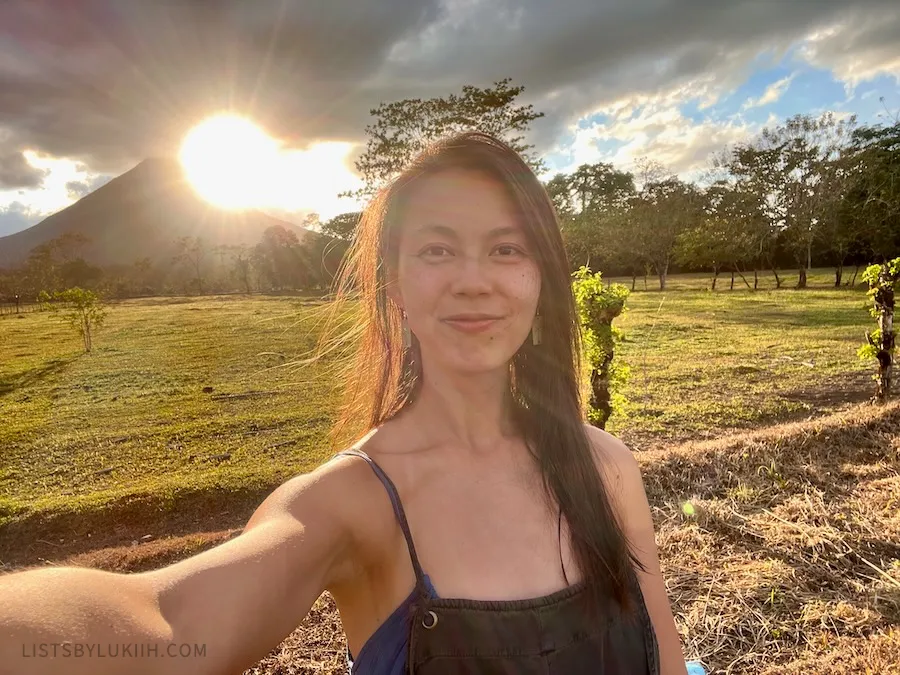
📍 Getting to La Fortuna
La Fortuna is in Costa Rica’s northern Highlands. It is two and a half hours from the country’s two international airports located in Liberia and San José. For this itinerary, I recommend flying into the latter.
You can get to La Fortuna by rental car, shuttle, taxi, bus, or domestic flight (the town has a small airport).
See how to get to and around La Fortuna.
🌟 Top Attractions in La Fortuna
La Fortuna is a great gateway to many quintessential Costa Rican activities and attractions. Here are some of my favorite activities there, listed in the order of the itinerary above:
- Hot springs – La Fortuna is located near the Arenal Volcano, which heats over a dozen nearby hot springs ranging from budget to high-end.
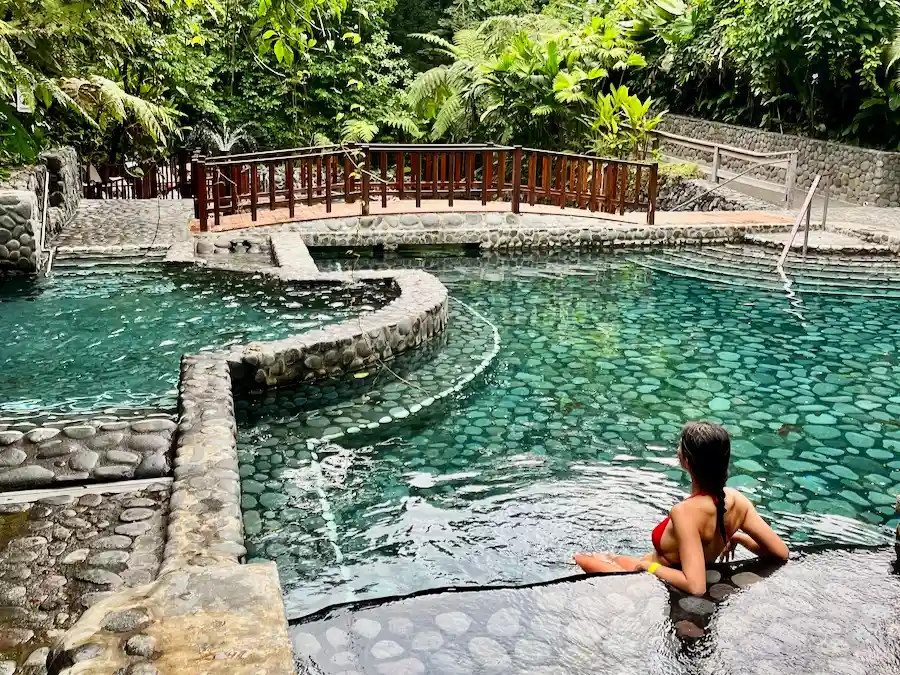
- Chocolate and coffee tours – Costa Rica is known for producing high-quality cocoas. I enjoyed this yummy and educational chocolate and coffee tour.
- Arenal Volcano – You can’t legally go to the top of the volcano, but you can explore around it. This Arenal Volcano horseback riding tour was one of the highlights of my trip.
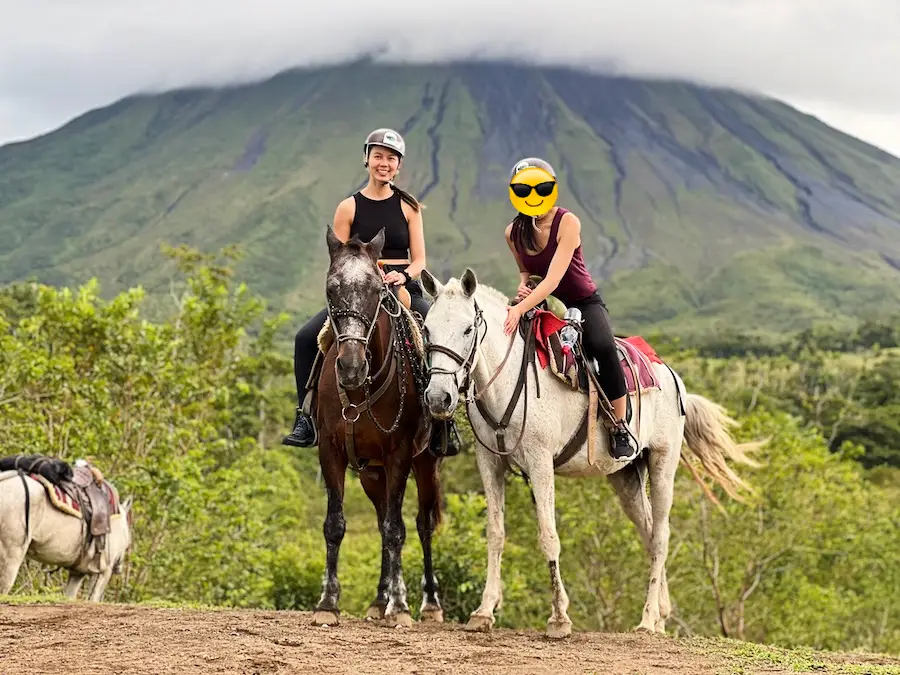
- Mistico Arenal Hanging Bridges – This rainforest features several suspension bridges for visitors to look out of. If you’re lucky, you can also spot wildlife.
- La Fortuna Waterfall – This waterfall is one of the town’s most popular and accessible attractions. You can also swim in it.
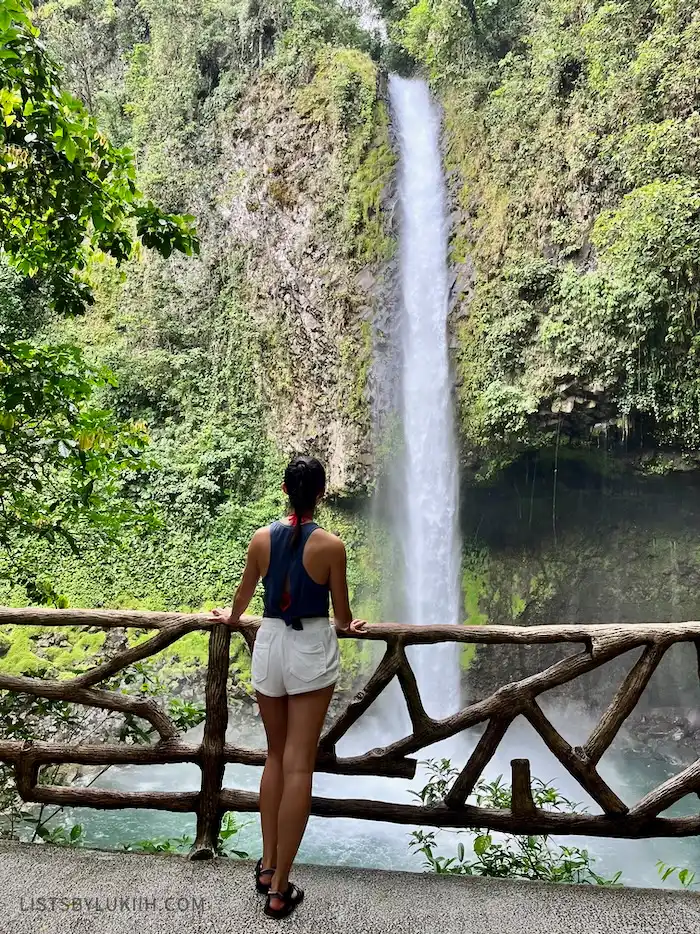
- La Fortuna Sky Tram — On a clear day, you can take a sky tram to see the Arenal Volcano and the surrounding area from above.
- Whitewater rafting – Costa Rica offers world-class classes ranging from I to IV. I had a blast doing a class III whitewater rafting with WAVE.
- Rio Celeste – If you have extra time, consider going further out to visit the stunning Rio Celeste, a unique river in Tenorio Volcano National Park due to its bright turquoise water.
Learn more tips and details on La Fortuna’s attractions.
🏠 Where To Stay in La Fortuna
All the happening places, restaurants, and tour meetup points are in the town center of La Fortuna. You’ll want to stay within walking distance of it or you’ll need to rely on taxis to get into town (I tried to walk a lot; the sidewalks are not great outside of town.)
While in La Fortuna, I stayed at an Airbnb right outside of town and Cabañas del Río, a mile outside town. The latter had a great hotel concierge who helped me book tours and call taxis, but getting to town from there was harder.
🍀 Lukiih’s Tips for La Fortuna
La Fortuna was my favorite place to visit during my trip to Costa Rica because of its many activities and pedestrian-friendly town.
Here are my overall tips for visiting this small town:
- Eat at the sodas – Soda is what Costa Ricans call their small local restaurants. There are a few of them in La Fortuna that serve some of my favorite meals.
- Aim for three to four days in La Fortuna – I spent a week there and thoroughly enjoyed it, but I recommend a maximum of four days for most visitors with more limited time.
See other tips for visiting La Fortuna.
Monteverde (Days 5-6)
On your fifth day, cross the Arenal Lake to reach Monteverde.
🌳 Why Visit Monteverde?
Monteverde, which translates to Green Mountain, is famous for its cloud forests and cooler climate.
Cloud forests are tropical rainforests with a persistent cloud cover at the canopy level, giving the forest a mystical look.

📍 Getting to Monteverde
Sitting on a mountain range over 4,600 feet above sea level, Monteverde is two and a half hours away from Liberia and San José’s international airports.
You can get to Monteverde by rental car, shuttle, taxi, or bus. Monteverde does not have a nearby airport.
Although Monteverde is close to La Fortuna, no direct road connects the two towns. The most direct way to travel between them is to take a shuttle-boat-shuttle across Lake Arenal.
🌟 Top Attractions in Monteverde
Monteverde is primarily known for its cloud forests, so its attractions are typically related to visiting those rainforests.
Here are some of the best things to do there, listed in the order of the itinerary above:
- Monteverde Butterfly Garden – Monteverde has several locations focused on specific animals found in Costa Rica. I had a great time learning about butterflies, but the town also has a nearby bat jungle, frog pond, and orchid garden.
- Wildlife Refuge night walk – Many animals become more active at night, so make sure to go on a night walk in a rainforest with a guide.
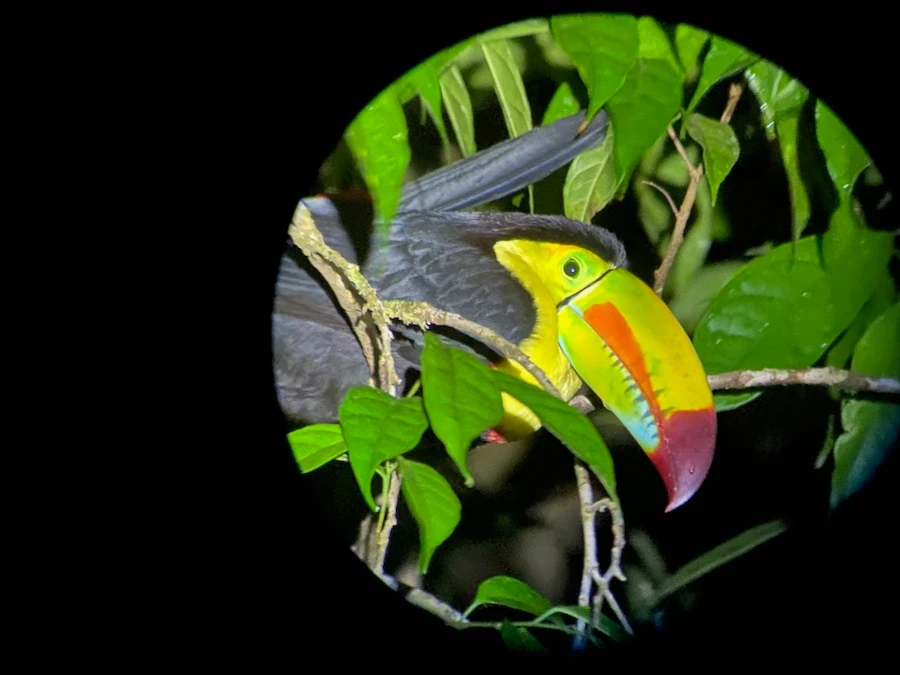
- Monteverde Cloud Forest – Monteverde’s most well-known cloud forests are Monteverde Cloud Forest Reserve, Santa Elena Cloud Forest Reserve, and Bosque Eterno de los Niños. Make sure to visit one of them during your trip.
- Sloth sanctuary – Sloths are one of Costa Rica’s most iconic animals, and Monteverde has a sanctuary featuring more than 20.
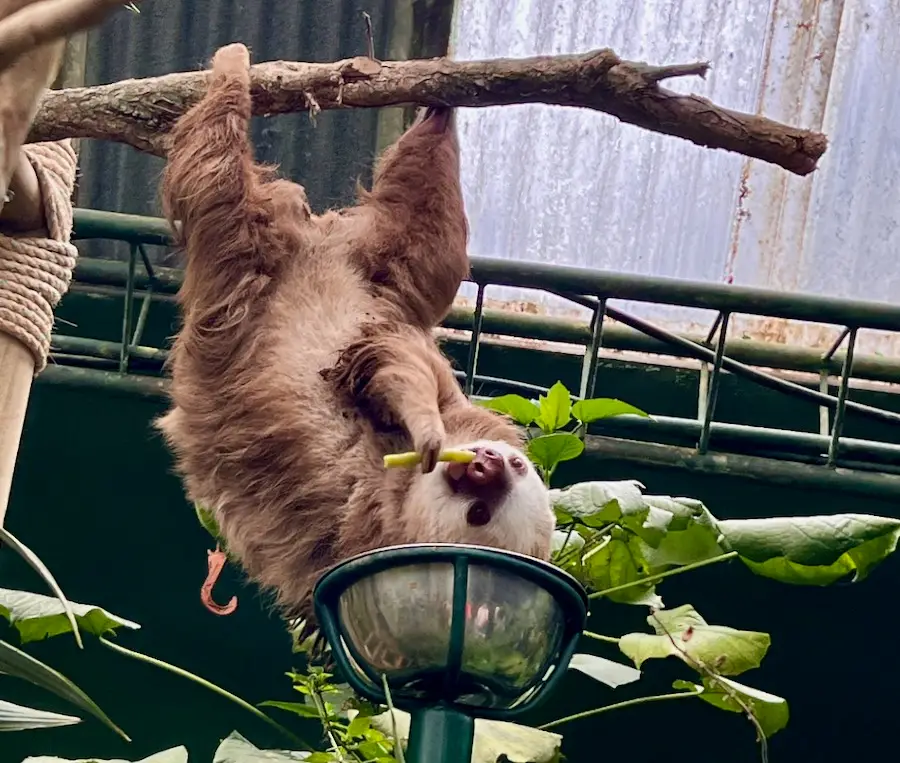
- Cloud forest zip lining – Zip lining over a cloud forest is a magical experience that’s unlike zip lining over other rainforests.
Learn more tips and details on Monteverde’s attractions.
🏠 Where To Stay in Monteverde
Monteverde is on a mountain range, so several accommodations are perched on the side of a valley, offering stunning views. These accommodations are usually located a few minutes’ walk outside the town area.
I stayed at Rainbow Valley Lodge, which offers cabin-style lodging. The views are incredible, and I saw a giant rainbow while staying there.
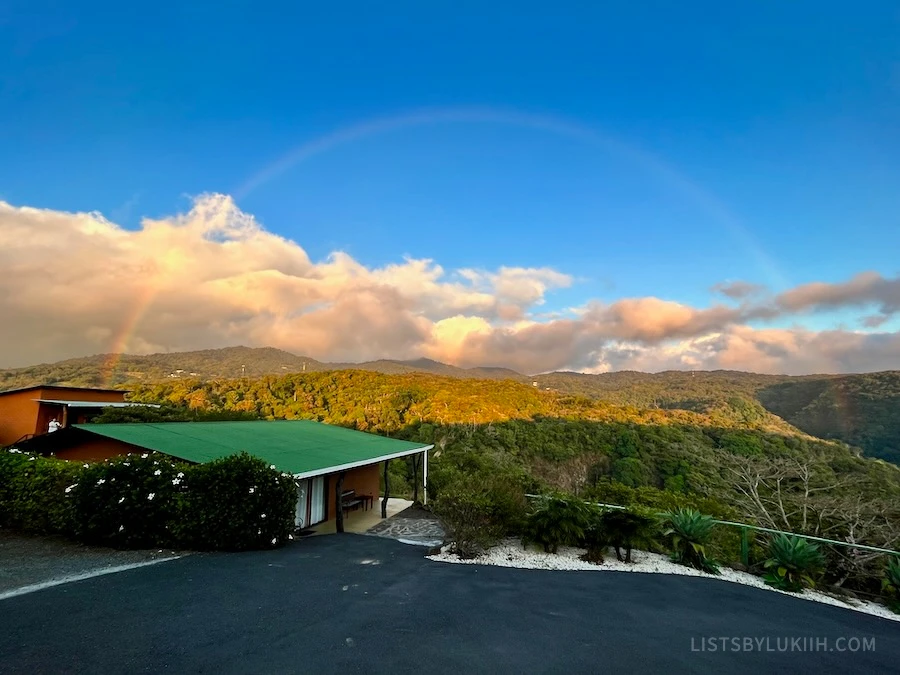
🍀 Lukiih’s Tips for Monteverde
Here are my overall tips for visiting this town:
- If you’re going to zip line in Costa Rica, do it in Monteverde – Zip lining over the cloud forest was one of the most magical experiences I had in Costa Rica. Monteverde also offers the longest zip line in the country.
- Pack warm, water-resistant layers – Monteverde is known to be much colder and rainier (sometimes dipping into the high 50s °F when everywhere else is above 70 °F). Pack some light, warm layers and a light rain jacket or rain poncho.
- Don’t spend more than three days here – Two days is sufficient to see most of Monteverde’s big attractions.
See other tips for visiting Monteverde.
Manuel Antonio (Option 1 for Days 7-9)
After Monteverde, head south to one of the country’s famous beach towns.
🏝️ Why Visit Manuel Antonio?
Manuel Antonio is a coastal village known for its white sand beaches and lush jungles. It ranks as one of Costa Rica’s most popular beach towns.
Compared to Nosara, Manuel Antonio has a much more crowded and touristy atmosphere combined with your typical relaxed beach vibe.
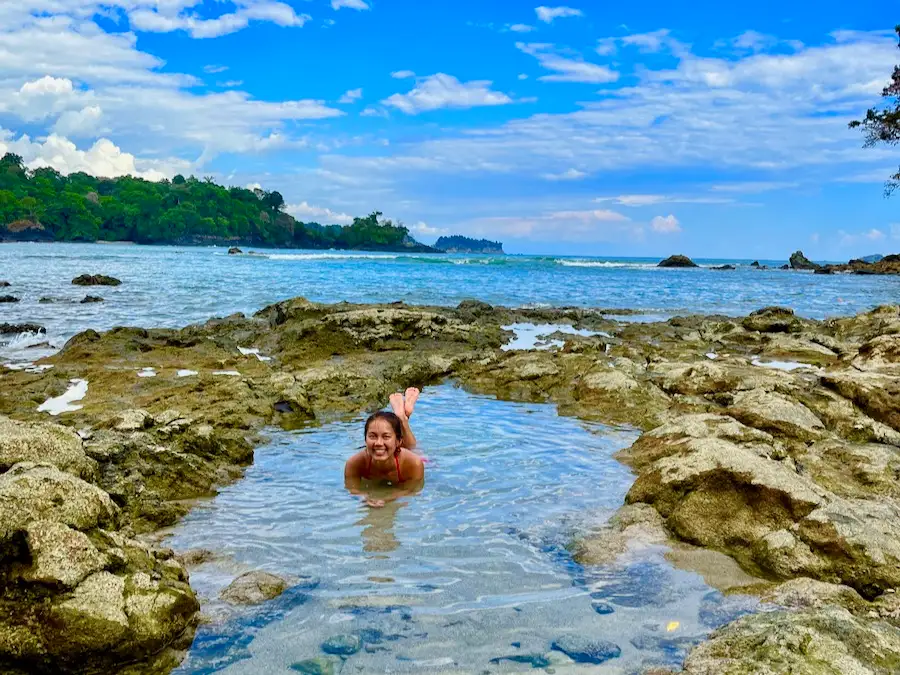
📍 Getting to Manuel Antonio
Located on the Pacific coast, Manuel Antonio is 104 miles south (about a three-hour drive) of San José’s international airport.
You can get to Manuel Antonio by rental car, shuttle, taxi, bus, or plane. The road to Manuel Antonio is mostly flat, so it’s an easy drive if you’re doing it on your own.
🌟 Top Attractions in Manuel Antonio
Here are Manuel Antonio’s top attractions and activities, listed in the order of the itinerary above:
- Playa Biesanz – Biesanz Beach is a tropical beach with beautiful natural scenery. It also has warm water that’s comfortable to snorkel in (though it is not always clear).
- Sunset at El Avion – Like many other beach towns in Costa Rica, Manuel Antonio is known for its vivid sunsets. One of the most popular places to catch one is at El Avion restaurant (get there early for good seats).
- Manuel Antonio National Park – Manuel Antonio National Park is the town’s most famous attraction. It features well-maintained trails, wildlife, and beautiful white-sand beaches. You need to get tickets in advance.
- Sunset at Playa Espadilla – Espadilla Beach is a large beach popular with locals and tourists. I spent many hours on this beach.
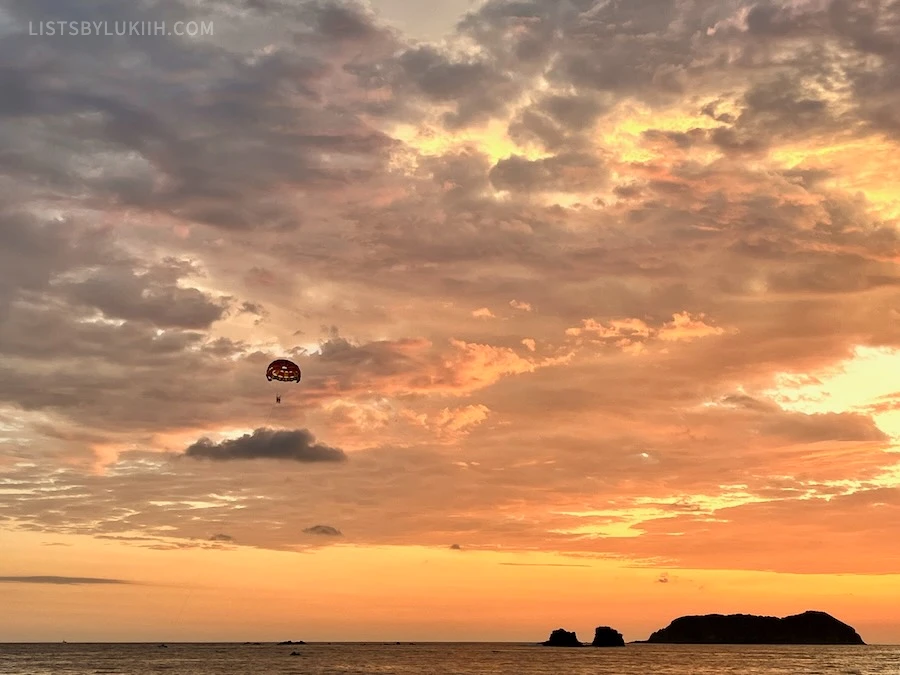
🍀 Lukiih’s Tips for Manuel Antonio
Here are my overall tips for visiting this town:
- Enjoy the beaches – While Manuel Antonio was my least favorite area of the four destinations I visited in Costa Rica, it has some of the best beaches I have ever seen.
- The local buses are convenient but not tourist-friendly – Many hotels and restaurants in Manuel Antonio are located on a hill. The local buses are a cheap and convenient way to get around, but knowing some Spanish is helpful when navigating them.
- Manuel Antonio is a great option if you have limited time – This beach town is much easier to get to from San José compared to Nosara, so it’s a great option if you don’t want to travel too far.
Nosara (Option 2 for Days 7-9)
If you prefer to visit a more tranquil beach town, head to Nosara after Monteverde.
🏄♀️ Why Visit Nosara?
Nosara is a beach town known for its world-renowned surf and yoga culture, beautiful beaches with stunning sunsets, and an international community of local Ticos, expats, and digital nomads.
It’s the perfect place for a relaxing and tranquil beach vacation that’s more remote.
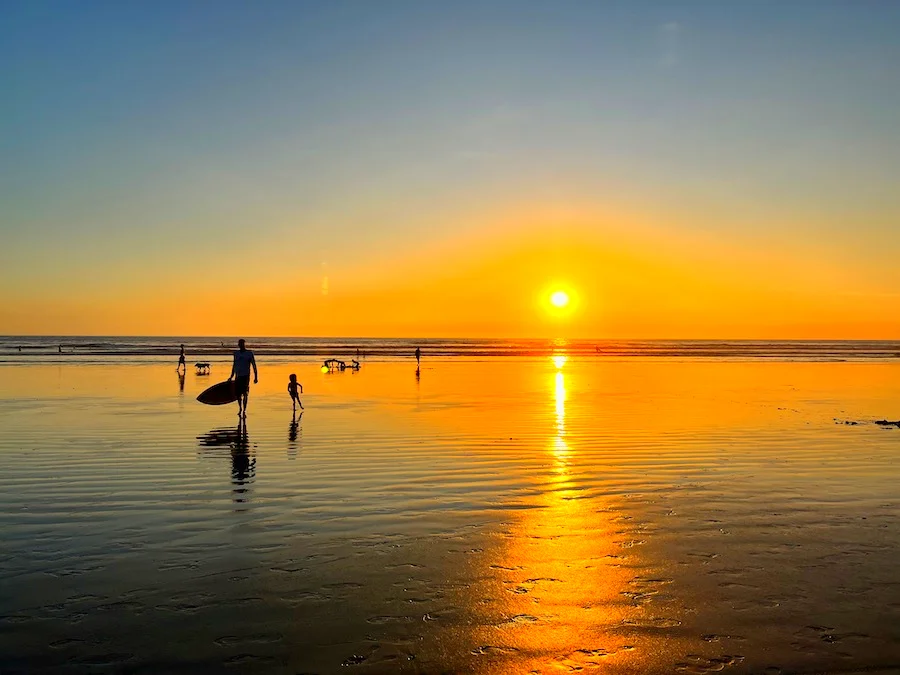
📍 Getting to Nosara
Located in the Nicoya peninsula, Nosara is 80 miles south of the closest international airport, Guanacaste Airport in Liberia.
You can get to Nosara by car rental, shuttle, taxi, bus, or plane (the town has a small airport).
The road leading to Nosara is winding and has a lot of potholes, so it’s a good idea to be well-prepared if you are driving yourself.
🌟 Top Attractions in Nosara
Nosara is one of the places in Costa Rica where you only need a little upfront planning. Here are some great things to do there:
- Surf and yoga lessons – Nosara is known for its surf and yoga culture. You can take surfing and yoga lessons from world-renowned practitioners at reasonable prices.
- Vivid sunsets – Some of my favorite sunsets in Costa Rica were in Nosara. The sky turns all shades of colors and lasts for a while.
- Olive Ridley sea turtles’ arrival – Olive Ridley sea turtles arrive in massive numbers to nest at Playa Ostional, creating a world-famous event that happens year-round at least once a month.
- ATV ride – For something more adventurous, ATV rides through the nearby mountains and waterfalls are offered in Nosara.
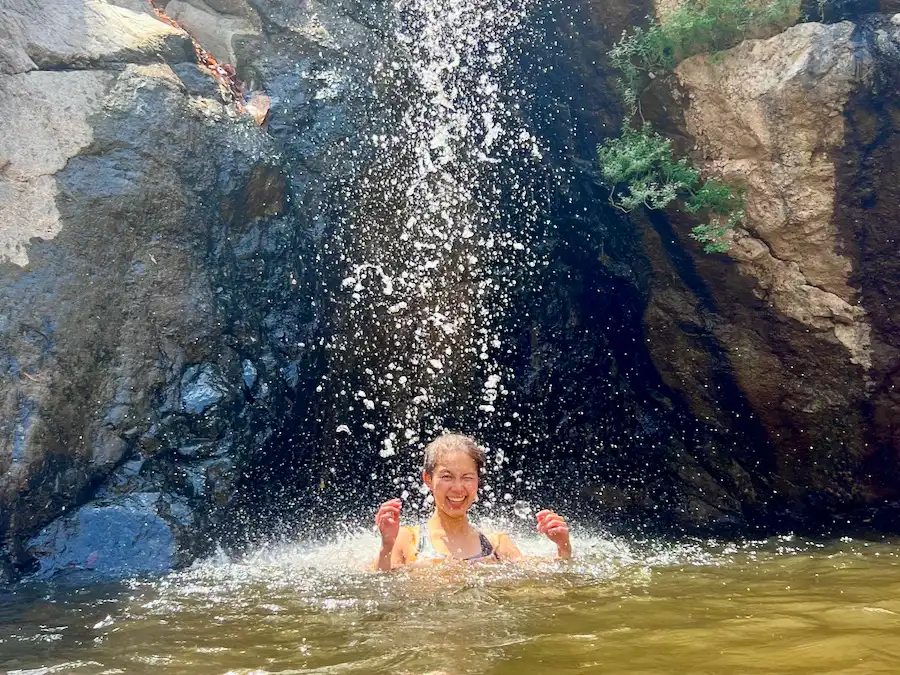
Learn more tips and details on Nosara’s attractions.
🏠 Where To Stay in Nosara
The majority of visitors don’t stay in Nosara’s town center. They stay near the shops, yoga studios, surf classes, and restaurants in Downtown Guiones, which makes things more accessible.
I stayed at Olas Verdes Hotel, which has a direct, short walking path to Guiones Beach. The staff was exceptional, and the attached restaurant had many great options for fresh fruits.
🍀 Lukiih’s Tips on Nosara
Thanks to its wellness-minded vibe, beautiful beaches, and vivid sunsets, Nosara was the most relaxing area I visited during my trip to Costa Rica.
Here are my overall tips for visiting this town:
- Stay at least three days to make it worth it – Nosara is not the most accessible location, so I recommend visiting only if you can afford three days to a week there (many people stay much longer).
- Santa Teresa is an alternative destination – It is a beach town further south on the peninsula that’s also known for surfing but has a more backpacker-friendly environment.
- Don’t over-plan Nosara – Nosara is a town where you can show up and figure out what you want to do while you’re there. This is one of the benefits of visiting a more remote beach town.
See other tips for visiting Nosara.
Depart from San José or Liberia (Day 10)
If you’re in Manuel Antonio on day 9, travel back to San José’s international airport and take your flight out from there.
If you’re in Nosara on day 9, travel back to Liberia’s international airport and take your flight out from there.
To save significant transportation time, consider flying to Liberia from Nosara’s tiny airport.
How much will a trip set you back? I share my travel expenses in this Costa Rica budget breakdown.
With More Time: 12 to 14-Day Itinerary for Costa Rica
If you have an extra two or four days in Costa Rica, you can visit four regions instead of three. This is more similar to what I did during my two-week trip.
With 12 to 14 days in Costa Rica, you can visit the western and central regions of the country during your first visit.
A great two-week itinerary in Costa Rica can look like this:
| Days | Destinations |
|---|---|
| Days 1-4 | Nosara |
| Days 5-6 | Monteverde |
| Days 7-10 | La Fortuna |
| Days 11-14 | Manuel Antonio Optional: Spend some time in San José |
For a more off-the-beaten-path experience or during your second visit, you can head east to the Caribbean coast and visit amazing places like Tortuguero National Park. You can also head south to check out Corcovado National Park. Both the eastern and southern regions are more challenging to get to but are great for nature lovers.
Costa Rica Trip Planner
To make your travel planning easier, download the trip planner below and use it as a starting point. The planner has country-specific travel information, an itinerary, a packing list, and a map with key places pinned.
The trip planner is built on Notion, which I use for all my travel planning (I genuinely love this tool). If you don’t have Notion, creating an account is free.
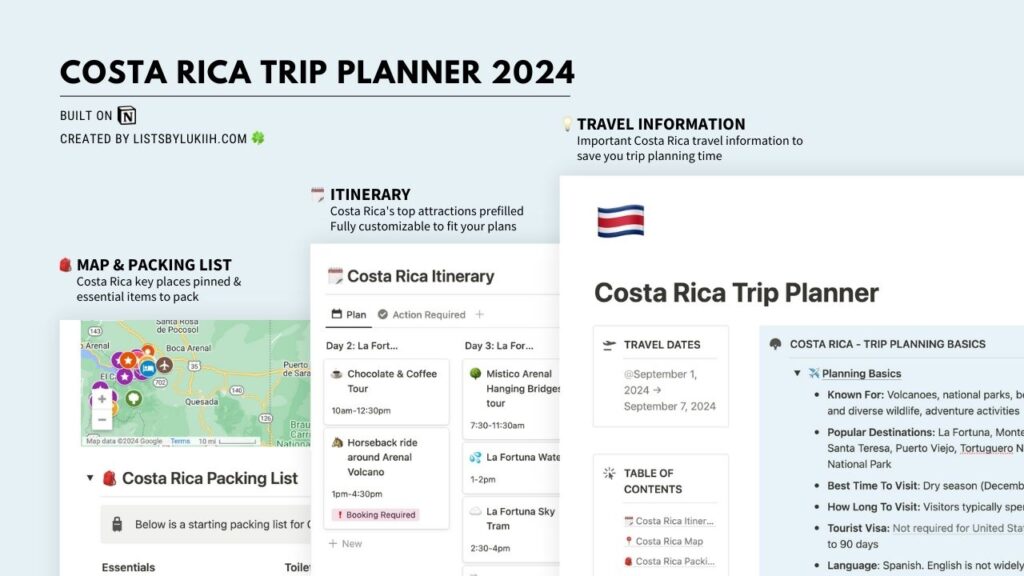
Thoughts? Questions? Leave a comment below.
Costa Rica Travel Guides
- 🇨🇷 Planning a Trip to Costa Rica: 11 Practical Things To Know
- 🦥 10 Amazing Days in Costa Rica: 2 Efficient Itineraries
- 💰 My 2024 Costa Rica Trip Cost: A Budget Breakdown
- 🌋 La Fortuna Guide: Top Things To Do + 3-5 Day Itinerary
- 🌳 Monteverde Guide: 2-3 Day Itinerary + 7 Great Things To Do
- 🏄🏻♀️ Nosara Travel Guide: 8 Best Things To Do + Itinerary
Lists by Lukiih is Readers-Supported
If you find my travel tips helpful, say thanks with a bubble tea🧋!
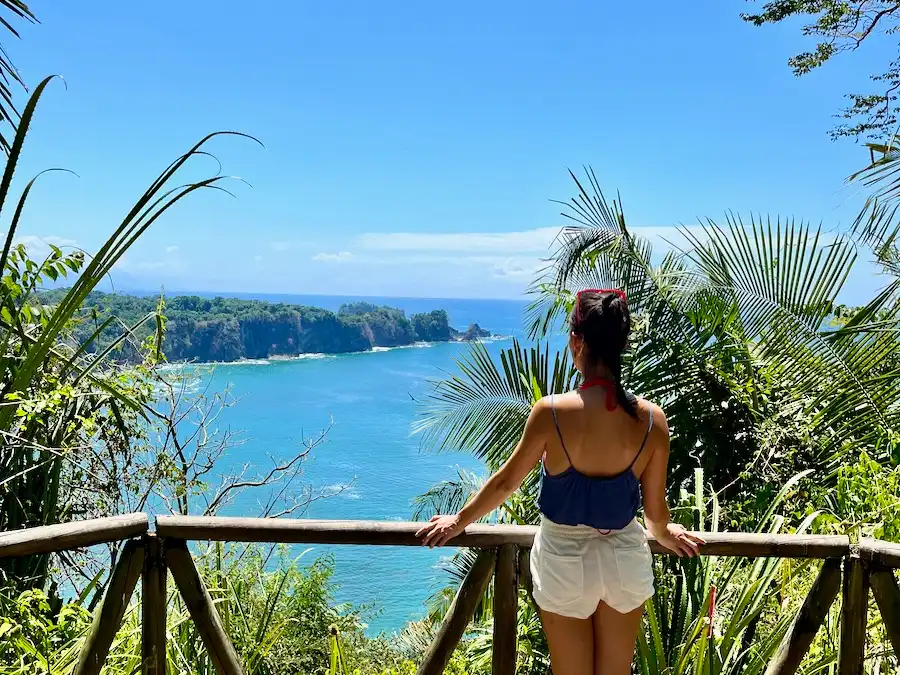
Planning a trip to Costa Rica in June and your blog has been very helpful. What hotels do you recommend for Itinerary Option 1? Thank you.
Hi Ramses, happy to hear you’ve found my travel guides helpful. I list the hotels I stayed at in La Fortuna and Monteverde here: https://listsbylukiih.com/costa-rica-trip-cost-breakdown/#accommodation-cost
For La Fortuna, I would recommend staying within walking distance of the small town. I stayed about a mile outside of it, and preferred staying closer to town because not doing so made things less convenient.
For Monteverde, I really liked the hotel I stayed in. It had a gorgeous view.
For Manuel Antonio, I stayed at an Airbnb within walking distance to the Manuel Antonio National Park, and that was fairly convenient to get to the town and beach.
Enjoy your trip!